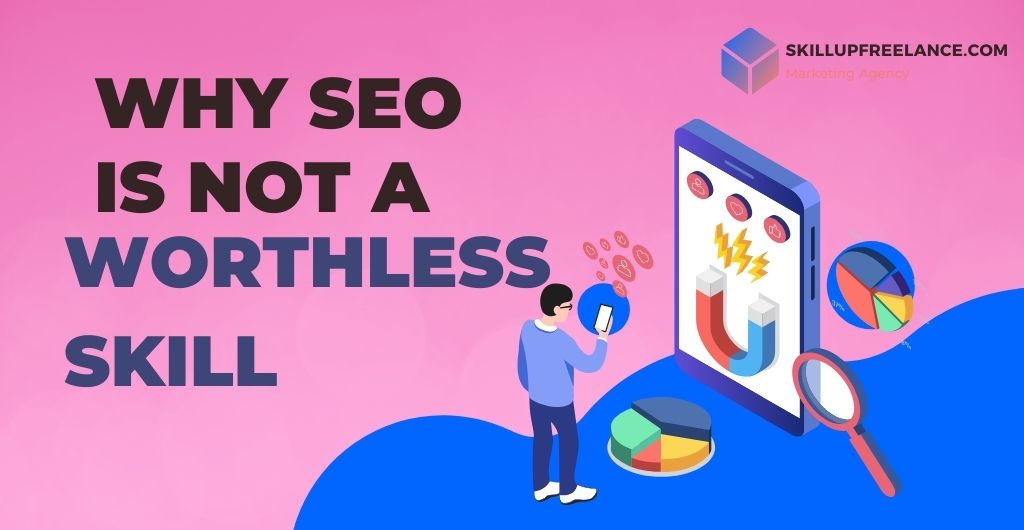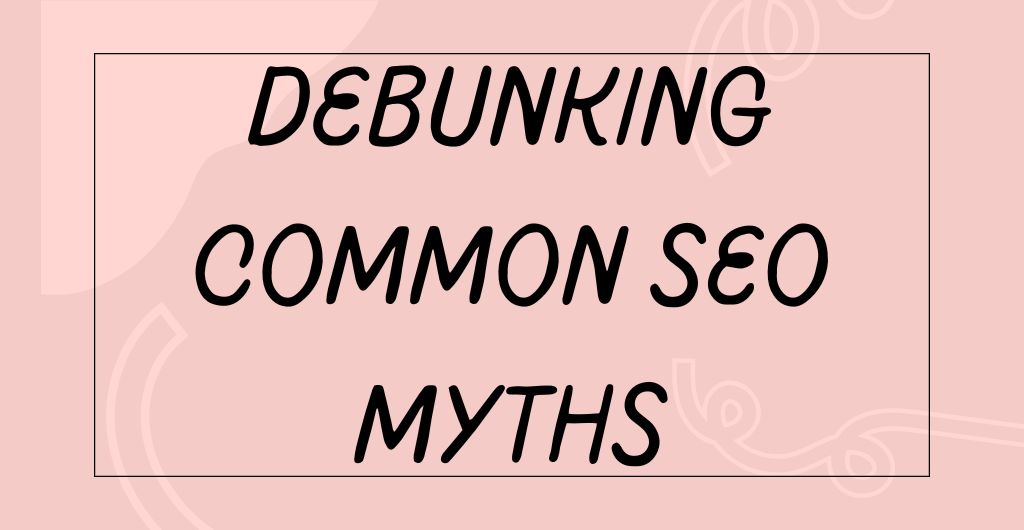Why SEO is Not a Worthless Skill: Busting Common Misconceptions
Introduction: The Unsung Hero of Digital Success
Thinking SEO is useless? Think again! In today’s digital age, where billions of searches are conducted daily, visibility is paramount. Yet, some still question the value of Search Engine Optimization (SEO). This article debunks these myths and highlights why SEO is not just a valuable skill, but a cornerstone of digital marketing success for businesses, marketers, and individuals alike.
Imagine a local bookstore struggling to compete with online giants. By implementing a targeted local SEO strategy, they can attract customers searching for “bookstores near me,” effectively leveling the playing field. This is the power of SEO.

1. SEO: Driving Sustainable Growth, Not Just Short-Term Gains
Unlike fleeting trends or paid advertising campaigns that stop generating results as soon as the budget runs out, SEO builds a foundation for long-term digital success. By improving a website’s visibility in organic search results, SEO drives consistent, sustainable traffic. This organic growth is crucial for establishing a lasting online presence and reaching a wider audience. Most online experiences begin with a search engine, making SEO critical for discovery and ensuring your business is found when it matters most.
Case Study: Organic Growth Success
Consider a small e-commerce store that invested in SEO over two years. By optimizing product pages, improving site speed, and building quality backlinks, they saw a 300% increase in organic traffic and a 200% boost in sales without additional advertising costs.
2. SEO vs. Paid Advertising: Investing in Long-Term Value
Although paid ads provide instant exposure, they necessitate ongoing financial commitment to maintain visibility. SEO, on the other hand, delivers ongoing results without incurring additional costs for each click. Furthermore, users tend to trust organic search results more than paid advertisements, perceiving them as more credible and relevant. A balanced approach that combines SEO with strategic paid advertising can create a powerful synergy, maximizing reach and impact.
Example: Trust in Organic Results
Surveys consistently show that 70-80% of users ignore paid ads and focus on organic results. This reliance on organic listings highlights the critical role of a strong SEO strategy.
| Aspect | Details |
|---|---|
| Longevity | SEO builds long-term visibility, while paid ads stop working once the budget ends. |
| Cost | SEO provides ongoing results without extra costs per click; paid ads require continuous investment. |
| Credibility | Users trust organic results more than paid ads, perceiving them as reliable and relevant. |
| User Behavior | 70-80% of users focus on organic results and often ignore paid ads. |
| Case Study |
A small e-commerce store invested in SEO and achieved:
|
3. SEO: Leveling the Playing Field for Businesses
SEO enables small businesses to level the playing field and compete effectively with larger corporations. A local bakery using local SEO can rank higher in “best bakery near me” searches than a large national chain that hasn’t optimized for local search. This allows smaller businesses to target specific local audiences and gain a competitive edge. Moreover, keyword research and analytics provide invaluable data-driven insights into customer intent and behavior, enabling businesses to tailor their strategies for maximum effectiveness. Consistently ranking high in search results also strengthens brand authority and builds trust with potential customers.
Data Insight: Local SEO Impact
Google My Business profiles optimized for local search see a 70% increase in visits. This demonstrates how local SEO can significantly boost foot traffic for small businesses.
4. SEO: Adapting to the Ever-Changing Digital Landscape
SEO is an evolving discipline that requires ongoing learning, adaptability, and a commitment to innovation. Professionals must stay updated on algorithm updates, industry trends, and technological advancements to maintain optimal performance. This dynamic nature of SEO ensures businesses remain competitive and responsive to changes in the digital environment.
Insight: Algorithm Updates
Google releases several updates annually, impacting how websites are ranked. Staying informed about these changes and adjusting strategies accordingly is crucial for maintaining visibility.
5. The Growing Demand for SEO Professionals: A Career with Staying Power
From e-commerce to healthcare, virtually every industry requires SEO expertise. This translates to diverse career opportunities for SEO professionals, who can specialize in areas like technical SEO, content strategy, local SEO, and more. As businesses increasingly rely on digital marketing, the demand for skilled SEO professionals will only continue to grow.
Career Growth: SEO Specializations
Specializations such as mobile SEO, voice search optimization, and international SEO are emerging, offering professionals new avenues for career development.
| Aspect | Details |
|---|---|
| Leveling the Playing Field | SEO helps small businesses compete with larger ones by targeting local audiences and building trust. |
| Local SEO Impact | Optimized Google My Business profiles see a 70% increase in visits. |
| Adapting to Change | SEO requires adapting to algorithm updates and industry trends for sustained visibility. |
| Demand for SEO Professionals | SEO offers diverse career opportunities, including technical, local, and voice search specializations. |
6. SEO: A Holistic Approach Beyond Keywords
SEO is far more than just keyword stuffing. It encompasses a range of technical elements crucial for website performance:
- Site Speed: Search engines prioritize fast-loading websites to provide a better user experience. A sluggish website can result in increased bounce rates and diminished search engine rankings.
- Mobile Optimization: With the majority of searches now performed on mobile devices, ensuring a website is mobile-friendly is essential for SEO success.
- Schema Markup: Implementing schema markup helps search engines understand the context of website content, improving visibility and click-through rates. User Experience (UX): Search engines favor websites that offer an excellent user experience, including easy navigation, clear calls to action, and compelling content.
- High-Quality Content: Producing valuable, informative, and engaging content that aligns with user intent is crucial. Websites that offer genuine value to their audience are rewarded by search engines.
Example: Impact of UX on Rankings
A study showed that improving UX led to a 60% increase in time spent on site and a 30% drop in bounce rate, directly impacting search rankings.
7. SEO: The Cornerstone of Integrated Marketing
SEO acts as a central hub, enhancing the effectiveness of various marketing strategies:
- Content Marketing: SEO ensures that valuable content is discoverable by the target audience through search engines. By optimizing blog posts, articles, and other content for relevant keywords, businesses can attract organic traffic and establish themselves as thought leaders.
- Social Media Marketing: While social media primarily drives traffic through direct links, SEO can amplify the reach of social media content. Optimizing website content related to social media campaigns can improve its visibility in search results, driving additional traffic.
- Email Marketing: SEO can generate leads for email marketing campaigns. By attracting visitors to landing pages through organic search, businesses can capture email addresses and nurture potential customers.
- Local Marketing: For businesses targeting local customers, local SEO is essential. Optimizing Google My Business profiles, building local citations, and creating location-specific content can improve visibility in “near me” searches, driving foot traffic and local engagement.
Visual Example: SEO and Content Marketing Synergy
An infographic showing how SEO enhances content visibility and drives organic traffic can help visualize this synergy.
| SEO: A Holistic Approach | |
|---|---|
| Key Elements | SEO includes fast loading, mobile-friendliness, schema markup, great UX, and valuable content to boost rankings and user engagement. |
| Impact of UX | Improved UX increases time on site by 60% and reduces bounce rates by 30%, directly enhancing rankings. |
| SEO in Marketing | |
| Marketing Benefits | SEO boosts content visibility, social media reach, organic traffic, and local search rankings. |
8. Measuring SEO Success: Data-Driven Results and ROI
SEO provides measurable results through tools like Google Analytics and Search Console. These tools offer insights into key metrics such as organic traffic, keyword rankings, and conversion rates, allowing businesses to track progress and refine their strategies. Compared to traditional marketing methods, SEO often delivers a high return on investment (ROI), making it a cost-effective strategy for long-term growth. A business might invest $1,000 in SEO and see a $5,000 increase in revenue due to organic traffic, demonstrating a significant return.
ROI Example: E-Commerce SEO
An e-commerce site that optimized its category pages saw a 50% increase in organic sales within six months, showcasing the tangible benefits of SEO.

9. Debunking Common SEO Myths
- Myth: SEO takes too long to show results. Reality: While SEO is a long-term strategy, consistent effort yields incremental gains that compound over time.
- Myth: SEO is only about ranking #1. Reality: SEO focuses on driving relevant traffic that converts into customers, not just achieving the top spot for every keyword.
- Myth: SEO is a one-time effort. Reality: Continuous optimization is essential to maintain visibility, adapt to algorithm updates, and stay ahead of the competition.
Myth Busting: Timeframe for Results
While it’s true that SEO takes time, businesses often see measurable improvements within three to six months of implementation, debunking the myth of indefinite delays.
Conclusion: Investing in Your Digital Future
SEO is not a fad or a “worthless” skill. It’s a fundamental component of digital marketing success. Whether you’re aiming for personal growth, career advancement, or business expansion, understanding and implementing SEO equips you to thrive in the digital age. By embracing SEO, you’re not just optimizing a website; you’re investing in a long-term strategy that drives visibility, credibility, and sustainable growth. Start learning and implementing SEO today and unlock the potential of organic search.
FAQ Section
1. What is SEO, and why is it essential?
SEO, or Search Engine Optimization, is the practice of improving a website’s visibility in search engine results pages (SERPs). It is important because it helps attract organic traffic, increase online visibility, and drive sustainable growth for businesses.
2. How long does it take to see results from SEO?
SEO is a long-term strategy. While some improvements can be seen within a few months, significant results typically take six months to a year of consistent effort.
3. Can small businesses benefit from SEO?
Yes, small businesses can benefit greatly from SEO. By optimizing for local searches and targeting specific audiences, small businesses can compete with larger companies and increase their online visibility.
4. What are the essential components of an effective SEO strategy?
The essential components include keyword research, on-page optimization, technical SEO, content creation, improving site speed, mobile optimization, and link building.
5. How does SEO complement other marketing strategies?
SEO complements other marketing strategies by enhancing content visibility, driving organic traffic, and providing data-driven insights that can improve social media marketing, email marketing, and overall brand strategy.
Helpful Materials Section
Recommended Books:
- “SEO 2023” by Adam Clarke
- “The Art of SEO” by Eric Enge, Stephan Spencer, and Jessie Stricchiola
- “SEO for Dummies” by Peter Kent
Online Resources:
Platforms to Learn SEO:
- Coursera (SEO Specialization by UC Davis)
- HubSpot Academy (SEO Training Course)
- Google’s Search Engine Optimization (SEO) Starter Guide
Visual Suggestions:
- Infographics summarizing key points.
- Case study illustrations or comparison charts.
- Screenshots or platform walkthroughs.